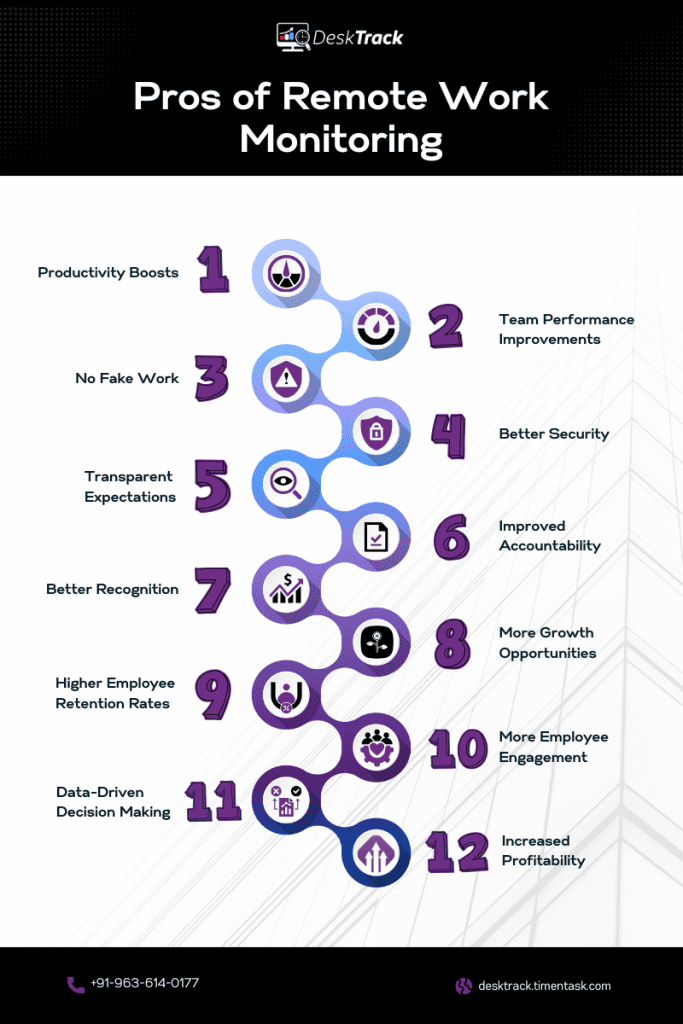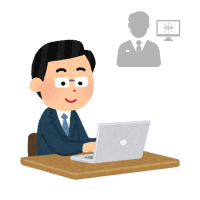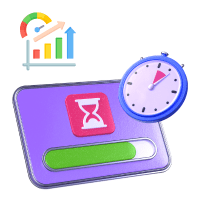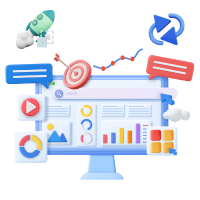Precisely, let’s get to the point already. Remote work monitoring vs. office-based time tracking: Which one should you choose? Like everything else, these also have their fair share of benefits and limitations. Another question is whether the pros are only for employers. We will discuss that as well.
Did you know that around 75% of employees are working remotely in 2025? This concludes that you need software to track work for sure. However, is an office-based employee monitoring and time tracking solution enough, or do you need more? By the conclusion of this post, you will have your answer.
Today, we will take a look at the advantages and disadvantages of both remote and work hours tracking. Plus, you will also get insights into how it all works towards assisting you in improving team efficiency and productivity for better success.
What is Remote Work Monitoring?
Make your workday more productive
Time tracking and work management can help you reach your goals
faster.
Remote work monitoring is employee monitoring only. However, when its focus shifts to work-from-anywhere employees, then some so-called technical experts rename it to remote employee activity tracking or the one you saw in the heading. Nonetheless, what is employee monitoring?
- It aims to accurately track and report employee efficiency and productivity levels.
- It is legal and not the same as spying on employees, as it focuses on improving work output rather than jeopardising privacy.
- Employee work monitoring software provides the flexibility of online and offline activity tracking with real-time tracking.
| Employee monitoring without software is possible. It’s called micromanagement. It is time-consuming, involves employer bias and favouritism, and is completely unethical. Furthermore, it breaks the professional trust of your employees. So there is only one effective way of remote and in-office work monitoring. That is to use employee monitoring software. |
Read Also: All You Need to Know About Productivity Monitoring Tools for Remote Teams
What are the Pros of Remote Work Monitoring?

It may not seem like it. However, surprisingly, there are many pros of remote work monitoring. Fairly enough, these are gained at the employers’ as well as employees’ end:
1. Productivity Boosts
Monitoring what your employees are doing and what they are not is your sure-shot way to skyrocket productivity. This is due to accurate time-data-based performance insights, which let you spot and fix or improve:
- Project delays
- Off-track workflows
- Task progress
- Work-time utilisation efficiency levels
- Work gaps
- Work flaws
- Skill gaps
- Obstructions
That too, without disrupting the flow of work, because you won’t even have to move from your seat to inform employees of any changes. With the right project management software, it all happens in real-time.
2. Team Performance Improvements
Tracking individual employee performance and how it contributes to team goals improves the work performance of your groups as a whole. Thanks to real-time analysis and reporting, you will know:
- Where your employees are lagging
- The coordination levels between your employees and teams
- As we mentioned before, take data-driven decisions to improve employee efficiency without moving from your seat. For instance, rescheduling the correct teams to the right tasks and projects.
3. No Fake Work
Remote employees can pretend to be working by leaving their mouse on automatic movement and/or typing gibberish on their keyboards. This gives an illusion that they are not idle and are working smart.
However, in reality, they are slacking or playing video games. However, with the right remote tracking software, you will get insights, such as URLs, apps used and files opened. So, your remote employees will have no choice but to work.
4. Better Security
Remote staff monitoring software also prevents data leaks and insider threats. By analysing employee behaviour and working patterns, it becomes easy to identify whether any unusual activity is an employee pain point or an insider threat.
5. Transparent Expectations
By monitoring your employees, you can provide them with more clarity on what you expect due to accurate data insights. Plus, identifying whether they are working up to or beyond what you require.
6. Improved Accountability
Since your employees know they are being monitored, and you know about their whereabouts due to screenshot monitoring software, your employees will not unnecessarily cause delays. Overall, you will have more employees who take responsibility and accountability for their work.
7. Better Recognition
Monitoring your employees assists you in categorising your employees into average, top performers, and those who are only there to get paid for doing absolutely nothing or worse, leaking your important data. What you can do next is:
- Reward hard-working employees
- Training average employees.
- Discontinue slackers from your organisation to recover losses.
The outcome of all this is higher employee retention and engagement.
8. More Growth Opportunities
Monitoring employees the right way also provides you with enough data to identify room for improvement. This gives your teams the ample time and opportunity to grow in their careers, improve their skills, and be a more beneficial asset to your organisation.
9. Higher Employee Retention Rates
Since you are recognising your employees fairly and without any bias, your employees show more dedication and engagement as they feel more included.
Overall, all this skyrockets your employee retention rate, leading to growth and expansion as you hire new employees for new roles and not to replace an existing team member.
10. More Employee Engagement
Monitoring employees makes it simple to identify unusual work patterns and unnecessary project stalls, which are also potential signs of employee pain points. Fixing these issues leads to your employees thinking that they are being heard, which increases engagement.
11. Data-Driven Decision Making
Did you know that around 50% of managers still make unfair or biased decisions? Without employee monitoring, your managers will make crucial decisions based on the employees they favour and with 100% bias.
However, this is not how it works. Enter staff activity tracking, which changes that and ensures fair and unbiased data-driven decision-making, which makes your workplace less toxic.
12. Increased Profitability
Finally, all this leads to increased profitability. Plus, that too, due to a cost-effective solution that is remote staff activity tracking software. This upshift in revenue is another factor, which leads to more growth and expanisin for your business.
What are the Cons of Remote Work Monitoring?
Comparatively, there are a few cons of remote work monitoring as well. The idea for success here is to tackle these cons and continuously improve skills to keep moving forward. Nonetheless, let’s look at some disadvantages of staff work monitoring.
1. Distrust
Before staff monitoring yields good results for you, your employees might start thinking that you don’t trust them. This:
- Decreases employee morale and engagement
- Employees start working like robots
- Resignation rates increase.
2. Privacy Concerns
Any slip-up or security leak in employee monitoring can lead to strong privacy concerns. Such issues can lead to confidential data being leaked or employees’ personal information not remaining personal anymore, such as employee profiles.
3. Legal Issues
While staff monitoring is legal, you also need to be very of your local state or district rules regarding it. For instance, you need to keep information like this confidential:
- Employee medical records
- Sensitive financial information
- Private communications
Failing to comply with these rules can lead to heavy fines or even a few years of imprisonment for you.
4. Employees are Always Active
Due to constant employee monitoring. Your employees always work on their toes. Even during breaks, your employees won’t be relaxed due to the fear of the software showing more idle time.
5. Software Misuse
The objective of using monitoring software for remote employees is to improve their efficiency and productivity. However, some managers might use it to micromanage employees, which will give them stress and anxiety.
6. Not Always 100% Accurate
There are many cases where insights from the said software are not 100% accurate. Here are a few instances of it.
- Suppose the performance report is showing a higher idle time. However, what if that time was meeting or brainstorming time?
- Another case can be that your employee worked. However, due to a specific situation, they had to work on someone else’s computer, leaving their system idle.
7. Implementation Challenges
If you implement staff work tracking software without any warnings or prior communication, then you have another thing coming. It will lead to:
- Chaos
- Confusion
- Resistance from employees.
What is Office-Based Time Tracking?
Keeping remote employees aside, let’s now focus on office-based time tracking. To summarise, it’s all about work-time utilisation analysis and reporting. I.e. How much time your employees are spending per activity. Here are a few points to remember regarding work hours monitoring:
- There are many ways to track employee time.
- It includes all hours between clock-in and clock-out, including break time, idle time, and work-time.
- This ensures accurate payroll, leading to employees getting paid on time, which increases job satisfaction.
With that being said, let’s get into the various ways to track the work-time of your staff.
-
- Manual Time Tracking: This is the traditional pen and paper registers and timesheeting thing.
- Punch Cards: Employees have to tap a card every time they start and end a task. This way of time recording is only off by a few seconds at max.
- Online Timesheets: Employees have to fill in time entries online. However, they can still miss crucial hours.
- Time Tracking Software: Automates and/or makes all the processes of time tracking automatic so that you and your employees focus more on crucial work.
What are the Pros of Office-Based Time Tracking?
![]()
Just like staff monitoring, there are many pros of office-based time tracking. Here are a few reasons, businesses and organisations implement time tracking software.
1. Accurate Project Budgeting
By tracking employee hours, you will know exactly how much time is being spent on various projects. By comparing the various time entries, you will know how much time and resources you need to plan, manage, execute, and complete projects successfully.
2. Improved Prioritisation
Tracking work time lets you set task priorities more efficiently. You would want to delegate short tasks for later and finish crucial tasks first. Overall, time tracking gives you more clarity on this aspect.
3. Identifies Time Wastage
Useful work-time utilisation insights let you easily identify tasks and activities that are eating up most of your time. For instance, even if your employees hardly take any breaks, meetings may consume a lot of time.
4. Accurate Work-Time Utilisation Reports
You get accurate work-time utilisation reports, which provide you with the exact reason why your projects stall or are delayed at times. Advanced software solutions even provide data analytics for more accuracy.
5. Improved employee Efficiency
Tracking employee time is also essential to improve their efficiency. This process lets you know whether your employees are meeting your expected requirements or not.
Read Also: Leave Management Software in 2025: Everything You Should Know
What are the Cons of Office-Based Time Tracking?
Similarly, there are a few cons of office-based time tracking as well. Other than the fact that it excludes remote teams, here are some other limitations of work-hour monitoring.
1. Increased Pressure & Stress
Constantly being faced with task timers and automatic work-time utilisation reports leads to employees being stressed out and under pressure. Thus, they force themselves to complete tasks on time, no matter what, ultimately leading to burnout.
2. Time-Consuming
Ironically, implementing time tracking software and/or tools takes time. This is due to:
- Complex setups
- Steep learning curve
- Training time
3. Time Tracking Over Work
It is very much possible that you may choose to track employee hours over work. So, instead of quality work, you may end up with a list of tasks and their time entries on your timesheet.
4. Decreased Creativity & Flexibility
Although time monitoring accrues project budget, it fixes a time for everything to be completed. This leaves no room for creativity and flexibility. That is the mindset that you could have done something better, but used time tracking as an excuse instead.
5. Just Another Task
Work hours tracking can also feel like another task added to your already dreadful workload. Eventually, you may start tracking time on unnecessary things, which is negative for your work-life balance.
What is the Bottomline?
To conclude on office-based time tracking vs remote work monitoring, we can say that each of these methods and tools to skyrocket employee productivity has its fair share of pros and cons. So, what do we need to do? The solution is to balance both online employee monitoring and time tracking to streamline processes. We propose that you use the best hybrid work monitoring software solution. DeskTrack is the ultimate time tracking, project management, productivity monitoring, and employee activity monitoring software for your on-site, in-office, and hybrid employees and teams.
Frequently Asked Questions (FAQ)
Q. What is Office-Based Time Tracking?
Ans.. To summarise, time tracking is all about work-time utilisation analysis and reporting. I.e. How much time your employees are spending per activity.
Q. What is Remote Work Monitoring?
Ans. Remote work monitoring is employee monitoring for remote teams. It ensures that your work-from-anywhere employees and teams don’t pretend to work and are more accountable and responsible for their tasks.
Q. What are the Pros and Cons of Remote Work Monitoring?
Ans. Below, we are mentioning the pros and limitations of employee monitoring.
Pros:
- Productivity Boosts
- Team Performance Improvements
- No Fake Work
- Better Security
- Transparent Expectations
- Improved Accountability
- Better Recognition
- More Growth Opportunities
- Higher Employee Retention Rates
- More Employee Engagement
- Data-Driven Decision Making
- Increased Profitability
Cons:
- Distrust
- Privacy Concerns
- Legal Issues
- Employees are Always Active
- Software Misuse
- Not Always 100% Accurate
- Implementation Challenges
Q. What are the Downsides of Time Tracking?
Ans. Here are a few reasons why organisations refrain from tracking the time of their employees.
- Increased Pressure & Stress
- Time-Consuming
- Time Tracking Over Work
- Decreased Creativity & Flexibility
- Just Another Task










